CHAPTER XIX.

LOSE by Sunnyside is one of those marvelous villages
with which America abounds: it has sprung up like a mushroom, and bears the
name of Irvington, in compliment to the late master of Sunnyside. A dozen
years ago not a solitary house was there, excepting that of Mr. Dearman, the
farmer who owned the land. Piermont, directly opposite, was then the sole
eastern terminus of the great New York and Erie Railway, and here seemed to
be an eligible place for a village, as the Hudson River Railway was then almost
completed. Mr. Dearman had one surveyed upon his lands; streets were marked
out, village lots were measured and defined; sales at enormous prices, which
enriched the owner, were made, and now upon that farm, in pleasant cottages,
surrounded by neat gardens, several hundred inhabitants are dwelling. One
of the most picturesque of the station-houses upon the Hudson River Railway
is there, and a ferry connects the village with Piermont. Morning and evening,
when the trains depart for and arrive from New York, many handsome vehicles
may be seen there. This all seems like the work of magic. Over this beautiful
slope, where so few years ago the voyager upon the Hudson saw only woodlands
and cultivated fields, is now a populous town. The owners are chiefly business
men of New York, whose counting rooms and parlours are within less than an
hour of each other.
Less than a mile below Irvington, and about half way between that village and Dobbs's Ferry, is the beautiful estate of Nevis, the home and property of the Honourable James A. Hamilton, eldest surviving son of the celebrated General Alexander Hamilton, one of the founders of the republic of the United States.*
*Nevis is the name of one of a group of the Antilles, where General Hamilton was born.
It stands on the brow of the river slope, in the midst of a
charming lawn, that extends from the highway to the Hudson, a distance of
half a mile, and commands some of the finest and most extensive views of that
portion of the river. The mansion is large, and its interior elegant. It presents
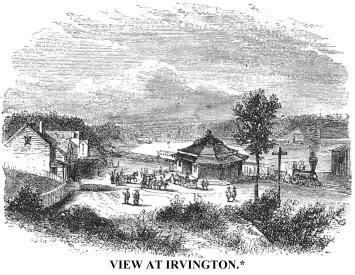 many attractions
to the lover of literature and art, aside from the delightful social atmosphere
with which it is filled. There may be seen the library of General Hamilton,
one of the choicest and most extensive in the country at the time of his death.
There, too, may be seen a portrait of Washington, by Stuart, painted for General
Hamilton, in 1798, when, in expectation of a war with France, the United States
organized a provisional government, and appointed him acting commanding general
under the ex-president (Washington), who consented to be the chief.
many attractions
to the lover of literature and art, aside from the delightful social atmosphere
with which it is filled. There may be seen the library of General Hamilton,
one of the choicest and most extensive in the country at the time of his death.
There, too, may be seen a portrait of Washington, by Stuart, painted for General
Hamilton, in 1798, when, in expectation of a war with France, the United States
organized a provisional government, and appointed him acting commanding general
under the ex-president (Washington), who consented to be the chief.
On the river bank of the Nevis estate is a charming little
cottage, completely embowered, where Mr. Irving was a frequent and delighted
visitor. It is the summer residence of Mr. Schuyler (a grandson of General
Schuyler), Mr. Hamilton's son-in-law. Near it is a more pretentious residence
belonging to Mr. Blatchford, another son-in-law of the proprietor of "Nevis."
Within call of these pleasant retreats is the superb residence of Mr. Cottinet,
a wealthy New York merchant, built in French style, of Caen stone. This, in
point of complete elegance, externally and internally, is 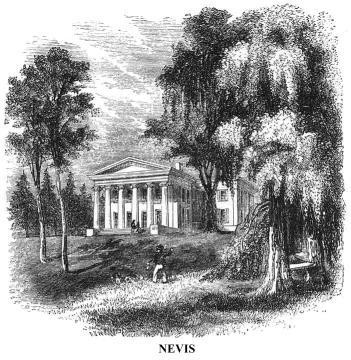 doubtless
superior to any other dwelling on the banks of the Hudson. The grounds about
it are laid out with much taste, and exhibit many delightful landscape effects.
doubtless
superior to any other dwelling on the banks of the Hudson. The grounds about
it are laid out with much taste, and exhibit many delightful landscape effects.
* From this point the traveler southward fist obtains a good view of the Palisades on the west side of the river.
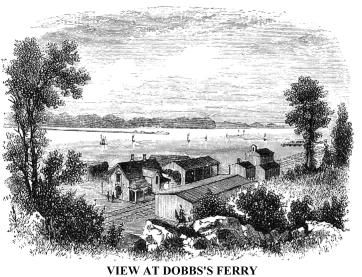 near
that spot our little sketch was taken, which included the long pier at Piermont,
the village of Nyack, and the range of hills just below Haverstraw, off which
the Vulture lay, and at the foot of which Arnold and André met. Several
other redoubts were cast up in this vicinity; these commanded the ferry to
Paramus, afterwards Sneden's Landing, and now Rockland.
near
that spot our little sketch was taken, which included the long pier at Piermont,
the village of Nyack, and the range of hills just below Haverstraw, off which
the Vulture lay, and at the foot of which Arnold and André met. Several
other redoubts were cast up in this vicinity; these commanded the ferry to
Paramus, afterwards Sneden's Landing, and now Rockland. Near Dobbs's Ferry the British rendezvoused, after the battle at White Plains, in October, 1776; and at Hastings, a mile below, a British force of six thousand men, under Lord Cornwallis, crossed the river to Paramus, marched to the attack at Fort Lee, and then pursued the flying Americans under Washington across New Jersey to the Delaware river. Here, in 1777, a division of the American army, under General Lincoln, was encamped; and here was the spot first appointed as the meeting-place of André and Arnold. Circumstances prevented the meeting, and it was postponed, as we have already observed. Here, in the mansion of Van Brugh Livingston, General Greene met the chief of three commissioners from General Sir Henry Clinton, in conference concerning Major André.
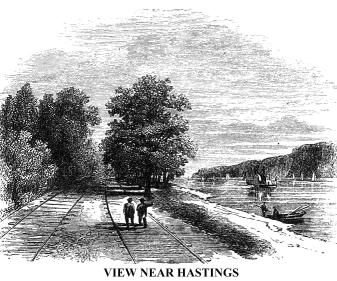 General
Robertson was the chief, and he had strong hopes, by imparting information
from General Clinton, to save the life of his young friend. Beverly Robinson
accompanied them as a witness. They went up in the Greyhound schooner, with
a flag of truce, but only General Robertson was permitted to land. Greene
met Robertson as a private gentleman, by permission of Washington, and not
as an officer. He was willing to listen, but the case of an acknowledged spy
admitted of no discussion. The subject was freely talked over, and Greene
bore from Robertson a verbal message to Washington, and a long explanatory
and threatening letter from Arnold. No new facts bearing upon the case were
presented, and nothing was offered that changed the minds of the court or
the commanding general. So the conference was fruitless.
General
Robertson was the chief, and he had strong hopes, by imparting information
from General Clinton, to save the life of his young friend. Beverly Robinson
accompanied them as a witness. They went up in the Greyhound schooner, with
a flag of truce, but only General Robertson was permitted to land. Greene
met Robertson as a private gentleman, by permission of Washington, and not
as an officer. He was willing to listen, but the case of an acknowledged spy
admitted of no discussion. The subject was freely talked over, and Greene
bore from Robertson a verbal message to Washington, and a long explanatory
and threatening letter from Arnold. No new facts bearing upon the case were
presented, and nothing was offered that changed the minds of the court or
the commanding general. So the conference was fruitless.
The Livingston mansion, owned by Stephen Archer, a Quaker,
is preserved in its original form; 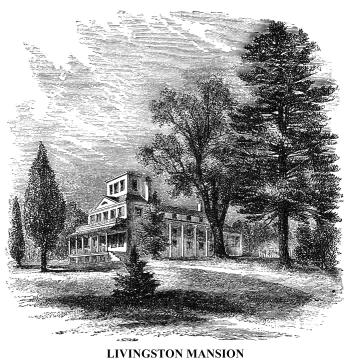 under
its roof, in past times, many distinguished men have been sheltered. Washington
had his head-quarters there towards the close of the revolution; and there,
in November, 1783, Washington, George Clinton, "the civil governor of
the State of New York," and Sir Guy Carleton, the British commander,
met to confer on the subject of prisoners, the loyalists, and the evacuation
of the city of New York by the British forces. The former came down the river
from Newburg, with their suites, in barges; the latter, with his suite, came
up from New York in a frigate. Four companies of American light infantry performed
the duties of a guard of honour on that occasion.
under
its roof, in past times, many distinguished men have been sheltered. Washington
had his head-quarters there towards the close of the revolution; and there,
in November, 1783, Washington, George Clinton, "the civil governor of
the State of New York," and Sir Guy Carleton, the British commander,
met to confer on the subject of prisoners, the loyalists, and the evacuation
of the city of New York by the British forces. The former came down the river
from Newburg, with their suites, in barges; the latter, with his suite, came
up from New York in a frigate. Four companies of American light infantry performed
the duties of a guard of honour on that occasion.
Opposite Dobbs's Ferry and Hastings is the most picturesque
portion of the "Palisades," to which allusion has several times
been made. These are 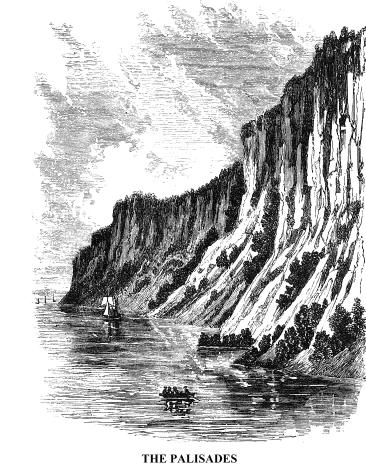 portions
of a ridge of trap-rocks extending along the western shore of the Hudson from
near Haverstraw almost to Hoboken, a distance of about thirty-five miles.
Between Piermont and Hoboken, these rocks present, for a considerable distance,
an uninterrupted, rude, columnar front, from 300 to 500 feet in height. They
form a mural escarpment, columnar in appearance, yet not actually so in form.
They have a steep slope of débris, which has been crumbling from the
cliffs above, during long centuries, by the action of frost and the elements.
The ridge is narrow, being in some places not more than three-fourths of a
mile in width. It is really an enormous projecting trap-dyke. On the top and
among the débris, in many places, is a thin growth of trees. On the
western and southern sides of the range, the slope is gentle, and composed
generally of rich soil covered with trees. Below Tappan it descends to a rich
valley, through which a railway now passes.
portions
of a ridge of trap-rocks extending along the western shore of the Hudson from
near Haverstraw almost to Hoboken, a distance of about thirty-five miles.
Between Piermont and Hoboken, these rocks present, for a considerable distance,
an uninterrupted, rude, columnar front, from 300 to 500 feet in height. They
form a mural escarpment, columnar in appearance, yet not actually so in form.
They have a steep slope of débris, which has been crumbling from the
cliffs above, during long centuries, by the action of frost and the elements.
The ridge is narrow, being in some places not more than three-fourths of a
mile in width. It is really an enormous projecting trap-dyke. On the top and
among the débris, in many places, is a thin growth of trees. On the
western and southern sides of the range, the slope is gentle, and composed
generally of rich soil covered with trees. Below Tappan it descends to a rich
valley, through which a railway now passes.
Viewed from the river this range presents a forbidding aspect; and little does the traveler dream of a fertile, smiling country at the back of this savage front. Several little valleys break through the range, and give glimpses of the hidden landscape beauties behind the great wall. In the bottoms of these the trap-dyke appears; so the valleys are only depressions in the range, not fractures.
Several bluffs in the range exceed 400 feet in height. The most elevated of all is one nearly opposite Sing-Sing, which juts into the river like an enormous buttress, and is a prominent object from every point on the Hudson between New York and the Highlands. It rises 660 feet above tide-water. The Dutch named it Verdrietigh-Hoeck--Grievous or Vexations Point or Angle--because in navigating the river they were apt to meet suddenly, off this point, adverse and sometimes cross winds, that gave them much vexation. The Palisades present a most remarkable feature in the scenery of the Lower Hudson.
Copyright © 1998, -- 2004. Berry Enterprises. All rights reserved. All items on the site are copyrighted. While we welcome you to use the information provided on this web site by copying it, or downloading it; this information is copyrighted and not to be reproduced for distribution, sale, or profit.